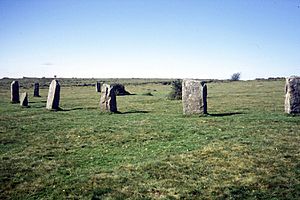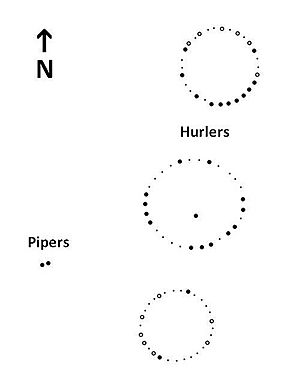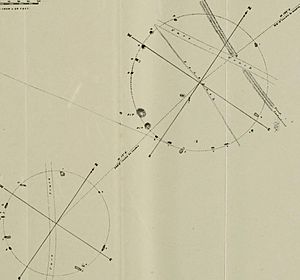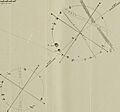The Hurlers (stone circles) facts for kids
The Hurlers (in Cornish, An Hurlysi) is a cool group of three ancient stone circles. You can find them in St Cleer, Cornwall, England. This amazing site is about half a mile (0.8 km) west of a village called Minions. It sits on the eastern side of Bodmin Moor, about four miles (6 km) north of Liskeard.
Contents
Where Are The Hurlers?
The Hurlers are located north of Liskeard in Cornwall. They are close to the village of Minions. This area is on the southern edge of Bodmin Moor. Just west of the circles, you'll find two tall standing stones. These are known as the Pipers.
Other interesting ancient sites are nearby too. These include Rillaton Barrow and Trethevy Quoit. Trethevy Quoit is an entrance grave from the Neolithic period. It's a very old burial place.
Why Are They Called The Hurlers?
The name "Hurlers" comes from a fun old legend. The story says that some men were playing Cornish hurling on a Sunday. This was seen as wrong because Sunday was a day of rest. As a punishment, they were magically turned into stones!
The two stones called "Pipers" have their own legend. They are said to be two men who played music on that same Sunday. They suffered the same magical fate. Another cool legend says you can never count the stones accurately. No matter how many times you try, you'll get a different number!
How Were The Hurlers Built?
The Hurlers are made up of three stone circles. They are lined up from south-southwest to north-northeast. Each circle has a different size. The first circle is about 35 meters (115 feet) across. The middle one, which is the largest, is about 42 meters (138 feet) wide. The third circle is about 33 meters (108 feet) across.
The two outer circles are perfectly round. The middle circle is a bit oval-shaped. The southern circle has had a tough time over the years. Only two of its nine stones are still standing upright. The other seven are partly covered by soil.
In the middle circle, 14 stones remain out of an original 28. You can see that these stones were hammered smooth a long, long time ago. The northern circle once had about 30 standing stones. Today, 15 of them are still visible. The two "Pipers" stones are about 100 meters (328 feet) southwest of the middle circle. They might have been entrance stones to The Hurlers.
Who First Wrote About The Hurlers?
The Hurlers were first written about a long time ago. The historian John Norden visited them around 1584. He was one of the first to mention them. Then, in 1586, William Camden described them in his book called Britannia. The first detailed description of the site was published in 1754 by William Borlase.
Digging Up The Past: Excavations
In the 1930s, a person named Ralegh Radford led some digs at the site. He helped to fix up the two northern circles. His team put some stones back upright. They also placed marker stones where missing stones used to be. Experts are still looking at his old reports today. They hope to learn even more from them.
More studies have happened since then. From 1975 to 1985, teams used aerial surveys. This means they took pictures from above to map the features. In 2004, English Heritage used special equipment to survey the ground. This helped them find things hidden underground.
In 2009, another survey suggested there might be a fourth circle! They also thought there could be two stone rows. The Hurlers became a protected ancient monument in 1981. The protected area was made bigger in 1994 to include the Pipers.
Who Looks After The Hurlers?
Today, The Hurlers are looked after by the Cornwall Heritage Trust. They manage the site for English Heritage. This means they help protect these ancient stones. They make sure people can visit and learn about them.
In 1999, some signs at the site were removed. After this, several smaller sites, including The Hurlers, were moved to the care of the Cornwall Heritage Trust. This helped ensure these important places were well-managed. Other sites transferred included Dupath Well, Tregiffian Burial Chamber, St Breock Downs Monolith, King Doniert's Stone, Trethevy Quoit, and Carn Euny.
Images for kids











